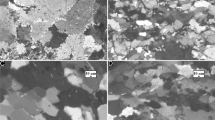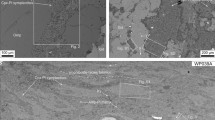Abstract
In order to characterize the µm-to-nm structures related to operation of pressure solution on phase boundaries in naturally deformed rocks, we have performed a detailed focused ion beam/transmission electron microscopy study in ultramylonite samples from South Armorican Shear Zone (France) that focused on grain boundary scale. We have studied phase boundaries between quartz, K-feldspar and white mica in both 2D and 3D and compare our evidences with theoretical dissolution precipitation models in the current literature. The dissolution (re)precipitation processes lead to the development of different features at different phase boundaries. In both quartz–white mica and quartz–K-feldspar phase boundaries, voids were ubiquitously observed. These voids have different shapes, and the development of some of them is crystallographically controlled. In addition, part of these voids might be filled with vermiculite. Amorphous leached layers with kaolinite composition were observed at the boundaries of K-feldspar–quartz and K-feldspar–white mica. The development of different features along the phase boundaries is mainly controlled by the crystallography of the phases sharing a common interface, together with the presence of fluids that either leaches or directly dissolve the mineral phases. In addition, the local dislocation density in quartz may play an important role during pressure solution. We suggest that the nanoscale observations of the quartz–white mica phase boundaries show direct evidence for operation of island-and-channel model as described in Wassmann and Stockhert (Tectonophysics 608:1–29, 2013), while K-feldspar–quartz phase boundaries represents amorphous layers formed via interface-coupled dissolution reprecipitation as described by Hellmann et al. (Chem Geol 294–295:203–216, 2012).










Similar content being viewed by others
References
Ballèvre M, Bosse V, Ducassou C, Pitra P (2009) Palaeozoic history of the Armorican Massif: models for the tectonic evolution of the suture zones. C. R. Geosci. 341:174–201
Berthé D, Choukroune P, Jegouzo P (1979) Orthogneiss, mylonite and non coaxial deformation of granites: the example of the South Armorican Shear Zone. J Struct Geol 1:31–42
Billia MA, Timms NE, Toy VG, Hart RD, Prior DJ (2013) Grain boundary dissolution porosity in quartzofeldspathic ultramylonites: implications for permeability enhancement and weakening of mid-crustal shear zones. J Struct Geol 53:2–14
Bray AW, Benning LG, Bonneville S, Oelkers EH (2014) Biotite surface chemistry as a function of aqueous fluid composition. Geochim Cosmochim Ac 128:58–70
Casey WH, Westrich HR, Banfield JF, Ferruzzi G, Arnold GW (1993) Leaching and reconstruction at the surfaces of dissolving chain-silicate minerals. Nature 366:253–255
Daval D, Hellmann R, Saldi GD, Wirth R, Knauss KG (2013) Linking nm-scale measurements of the anisotropy of silicate surface reactivity to macroscopic dissolution rate laws: new insights based on diopside. Geochim Cosmochim Ac 107:121–134
Di Toro G, Goldsby DL, Tullis TE (2004) Friction falls towards zero in quartz rock as slip velocity approaches seismic rates. Nature 427(6973):436–439
Fletcher RC (1998) Effects of pressure solution and fluid migration on initiation of shear zones and faults. Tectonophysics 295:139–165
Gratier JP, Favreau P, Renard P (2003) Modeling fluid transfer along California faults when integrating pressure solution crack sealing and compaction processes. J Geophys Res. doi:10.1029/2001JB000380
Gratier JP, Muquet L, Hassani R, Renard F (2005) Experimental microstylolites in quartz and modeled application to natural stylolitic structures. J Struct Geol 27(1):89–100
Gratier JP, Dysthe DK, Renard F (2013) The role of pressure solution creep in the ductility of the earth’s upper crust. Adv Geophys 54:47–179
Hellmann R, Penisson J-M, Hervig RL, Thomassin JH, Abrioux MF (2003) An EFTEM/HRTEM high-resolution study of the near surface of labradorite feldspar altered at acid pH: evidence for interfacial dissolution-reprecipitation. Phys Chem Miner 30:192–197
Hellmann R, Wirth R, Daval D, Barnes J-P, Penisson J-M, Tisserand D, Epicier T, Florin B, Hervig RL (2012) Unifying natural and laboratory chemical weathering with interfacial dissolution-reprecipitation: a study based on the nanometer-scale chemistry of fluid-silicate interfaces. Chem Geol 294–295:203–216
Hövelmann J, Putnis A, Geisler T, Schmidt BC, Golla-Schindler U (2010) The replacement of plagioclase feldspars by albite: observations from hydrothermal experiments. Contrib Miner Petrol 159:43–59
Knipe RJ (1993) The influence of fault zone processes and diagenesis on fluid flow. In: Horbury AD, Robinson AG (eds) Diagenesis and basin development, vol 36. AAPG Studies in Geology, Tulsa, OK, pp 135–154
Knipe RJ, Wintsch RP (1985) Heterogeneous deformation, foliation development, and metamorphic processes in a polyphase mylonite. Metamorphic Reactions. Springer, New York, pp 180–210
Kruhl JH, Wirth R, Morales LFG (2013) Quartz grain boundaries as fluid pathways in metamorphic rocks. J Geophys Res Sol Ea 118:1957–1967. doi:10.1002/jgrb.50099
Lehner FK (1995) A model for intergranular pressure solution in open systems. Tectonophysics 245(3):153–170
Mancktelow NS, Grujic D, Johnson EL (1998) An SEM study of porosity and grain boundary microstructure in quartz mylonites, Simplon Fault Zone, Central Alps. Contrib Miner Petrol 131:71–85
Menegon L, Pennacchioni G, Spiess R (2008) Dissolution-precipitation creep of K-feldspar in mid-crustal granite mylonites. J Struct Geol 30(5):565–579
Miyakawa K, Kawabe I (2014) Pressure solution of quartz aggregates under low effective stress (0.42–0.61 Mpa) at 25–45 °C. Appl Geochem 40:61–69
Nelson EP, Kullman AJ, Gardner MH, Batzle M (1999) Fault-fracture networks and related fluid flow and sealing, Brushy Canyon formation, West Texas. In: Haneberg WC et al (eds) Faults and subsurface fluid flow in the shallow crust, vol 113. AGU, Washington, DC, pp 69–81
Passchier CW, Trouw RA (1996) Microtectonics, Vol 2. Springer, Berlin
Platt JP, Behr WM (2011) Lithospheric shear zones as constant stress experiments. Geology 39(2):127–130
Putnis A (2009) Mineral replacement reactions. Rev Mineral Geochem 70:87–124
Putnis A, John T (2010) Replacement processes in the earth’s crust. Elements 6:159–164
Putnis A, Putnis CV (2007) The mechanism of reequilibration of solids in the presence of a fluid phase. J Solid State Chem 180:1783–1786
Renard F, Brosse É, Gratier JP (2000) The different processes involved in the mechanism of pressure solution in quartz-rich rocks and their interaction. Spec Publs int Ass Sedim 29:67–78
Rodriguez-Navarro C, Benning LG (2013) Control of crystal nucleation and growth by additives. Elements 6:203–209
Ruiz-Agudo E, Putnis CV, Rodriguez-Navarro C, Putnis A (2012) Mechanism of leached layer formation during chemical weathering of silicate minerals. Geology 40(10):947–950
Rutter EH (1976) The kinetics of rock deformation by pressure solution. Phil Trans R Soc Lond A 283:203–219
Rutter EH (1983) Pressure solution in nature, theory and experiment. J Geol Soc Lond 140:725–740
Spiers CJ, Schutjens PMTM (1990) Densification of crystalline aggregates by fluid phase diffusional creep. In: Barber DJ, Meredith PJ (eds) Deformation Processes in Minerals, Ceramics and Rocks. Unwin Hyman, London, pp 334–353
Stőckhert B, Wachmann M, Küster M, Bimmermann S (1999) Low effective viscosity during high pressure metamorphism due to dissolution precipitation creep: the record of HP-LT carbonates and siliciclastic rocks from Crete. Tectonophysics 303:299–319
Tartèse R, Boulvais P (2010) Differentiation of peraluminous leucogranites “en route” to the surface. Lithos 114:353–368
Tartèse R, Boulvais P, Poujol M, Chevalier T, Paquette JL, Ireland TR, Deloule E (2012) Mylonites of the South Armorican Shear Zone: insights for crustal-scale fluid flow and water–rock interaction processes. J Geodyn 56:86–107
Voll G (1976) Recrystallization of quartz, biotite and feldspars from Erstfeld to the Leventina Nappe, Swiss Alps, and its geological significance. Schweiz Mineral Petrogr Mitt 56:641–647
Wassmann S, Stőckhert B (2012) Matrix deformation mechanisms in HP-LT tectonic mélanges—microstructural record of jadeite blueschist from the Franciscan Complex, California. Tectonophysics 568–569:135–153
Wassmann S, Stőckhert B (2013) Rheology of plate interface—dissolution precipitation creep in high pressure metamorphic rocks. Tectonophysics 608:1–29. doi:10.1016/j.tecto.2013.09.030
Wheeler J (1987) The significance of grain-scale stresses in the kinetics of metamorphism. Contrib Miner Petrol 97:397–404
Wintsch RP, Dunning J (1985) The effect of dislocation density on the aqueous solubility of quartz and some geologic implications: a theoretical approach. J Geophys Res Solid Earth 90(B5):3649–3657
Wintsch RP, Kvale CM, Kisch HJ (1991) Open-system, constant-volume development of slaty cleavage, and strain-induced replacement reactions in the Martinsburg Formation, Lehigh Gap Pennsylvania. Geol Soc Am Bull 103(7):916–927
Wirth R (2009) Focused Ion Beam (FIB) combined with SEM and TEM: advanced analytical tools for studies of chemical composition, microstructure and crystal structure in geomaterials on a nanometre scale. Chem Geol 261:217–229. doi:10.1016/j.chemgeo.2008.05.019
Acknowledgments
Anja Schreiber is thanked for precise TEM foil preparation. This study was performed during the Erasmus Practical Placement provided by Charles University that allowed Z. Bukovská to work at the GFZ Potsdam, and the samples were collected during the field work supported by Charles University Grant Agency Project Nr.504112. We are grateful to J.P. Gratier, R. Wintsch and two anonymous reviewers for constructive comments that helped to improve this manuscript and to G. Moore for editorial work.
Author information
Authors and Affiliations
Corresponding author
Additional information
Communicated by Gordon Moore.
Electronic supplementary material
Below is the link to the electronic supplementary material.
3D slice-and-view movie along the quartz–white mica interface. The movie shows an interface of quartz (left) and white mica (right). The dissolution processes formed numerous voids along the phase boundary of the two mineral phases, which are opening and closing–documenting 3D character of the voids. Many of the voids are formed at lower left part, where the protruding voids move into the quartz from the interface of mica. Small grain of K-feldspar (white) occurs along the grain boundary of two quartz grains and in its vicinity another mica grain is grown. Just at the beginning of K-feldspar slicing, the pronounced opened grain boundary in between two quartz grains is present. With the growth of mica, numerous grain boundaries are more or less opened. Some of the voids are filled with late vermiculite (as shown on Fig. 4, 5)(MPG 6259 kb)
Rights and permissions
About this article
Cite this article
Bukovská, Z., Wirth, R. & Morales, L.F.G. Pressure solution in rocks: focused ion beam/transmission electron microscopy study on orthogneiss from South Armorican Shear Zone, France. Contrib Mineral Petrol 170, 31 (2015). https://doi.org/10.1007/s00410-015-1186-8
Received:
Accepted:
Published:
DOI: https://doi.org/10.1007/s00410-015-1186-8




